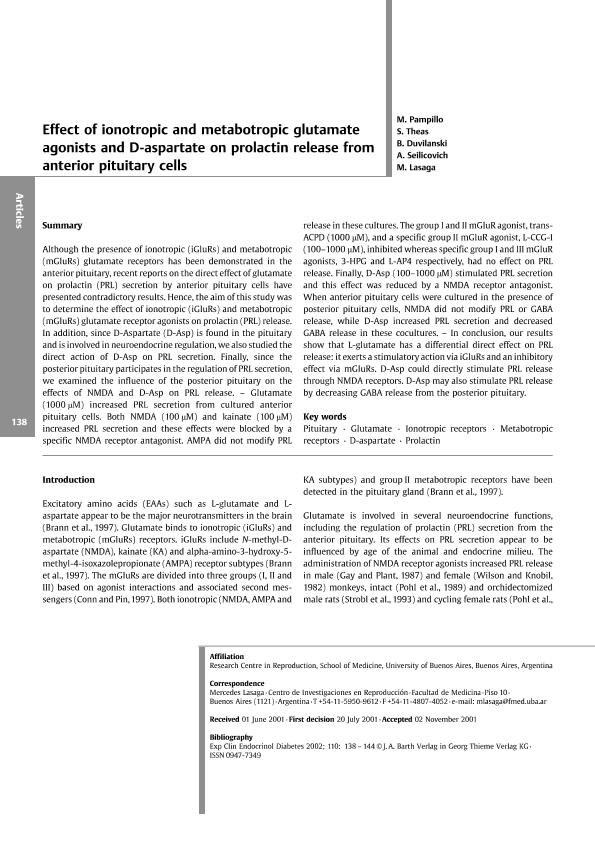Artículo
Effect of ionotropic and metabotropic glutamate agonists and D-aspartate on prolactin release from anterior pituitary cells
Pampillo, M.; Theas, Maria Susana ; Duvilanski, Beatriz Haydee
; Duvilanski, Beatriz Haydee ; Seilicovich, Adriana
; Seilicovich, Adriana ; Lasaga, Mercedes Isabel
; Lasaga, Mercedes Isabel
 ; Duvilanski, Beatriz Haydee
; Duvilanski, Beatriz Haydee ; Seilicovich, Adriana
; Seilicovich, Adriana ; Lasaga, Mercedes Isabel
; Lasaga, Mercedes Isabel
Fecha de publicación:
03/2002
Editorial:
Johann Ambrosius Barth Verlag Medizinverlage Heidelberg Gmbh
Revista:
Experimental Clinical Endocrinology & Diabetes
ISSN:
0947-7349
Idioma:
Inglés
Tipo de recurso:
Artículo publicado
Clasificación temática:
Resumen
Although the presence of ionotropic (iGluRs) and metabotropic (mGluRs) glutamate receptors has been demonstrated in the anterior pituitary, recent reports on the direct effect of glutamate on prolactin (PRL) secretion by anterior pituitary cells have presented contradictory results. Hence, the aim of this study was to determine the effect of ionotropic (iGluRs) and metabotropic (mGluRs) glutamate receptor agonists on prolactin (PRL) release. In addition, since D-Aspartate (D-Asp) is found in the pituitary and is involved in neuroendocrine regulation, we also studied the direct action of D-Asp on PRL secretion. Finally, since the posterior pituitary participates in the regulation of PRL secretion, we examined the influence of the posterior pituitary on the effects of NMDA and D-Asp on PRL release. - Glutamate (1000 μM) increased PRL secretion from cultured anterior pituitary cells. Both NMDA (100 μM) and kainate (100 μM) increased PRL secretion and these effects were blocked by a specific NMDA receptor antagonist. AMPA did not modify PRL release in these cultures. The group I and II mGluR agonist, trans-ACPD (1000 μM), and a specific group II mGluR agonist, L-CCG-I (100-1000 μM), inhibited whereas specific group I and III mGluR agonists, 3-HPG and L-AP4 respectively, had no effect on PRL release. Finally, D-Asp (100-1000 μM) stimulated PRL secretion and this effect was reduced by a NMDA receptor antagonist. When anterior pituitary cells were cultured in the presence of posterior pituitary cells, NMDA did not modify PRL or GABA release, while D-Asp increased PRL secretion and decreased GABA release in these cocultures. - In conclusion, our results show that L-glutamate has a differential direct effect on PRL release: it exerts a stimulatory action via iGluRs and an inhibitory effect via mGluRs. D-Asp could directly stimulate PRL release through NMDA receptors. D-Asp may also stimulate PRL release by decreasing GABA release from the posterior pituitary.
Archivos asociados
Licencia
Identificadores
Colecciones
Articulos(INBIOMED)
Articulos de INSTITUTO DE INVESTIGACIONES BIOMEDICAS
Articulos de INSTITUTO DE INVESTIGACIONES BIOMEDICAS
Articulos(OCA HOUSSAY)
Articulos de OFICINA DE COORDINACION ADMINISTRATIVA HOUSSAY
Articulos de OFICINA DE COORDINACION ADMINISTRATIVA HOUSSAY
Citación
Pampillo, M.; Theas, Maria Susana; Duvilanski, Beatriz Haydee; Seilicovich, Adriana; Lasaga, Mercedes Isabel; Effect of ionotropic and metabotropic glutamate agonists and D-aspartate on prolactin release from anterior pituitary cells; Johann Ambrosius Barth Verlag Medizinverlage Heidelberg Gmbh; Experimental Clinical Endocrinology & Diabetes; 110; 3; 3-2002; 138-144
Compartir
Altmétricas



